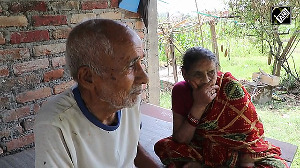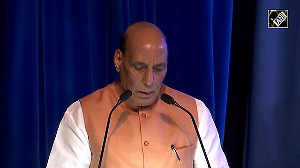The savings bank deposit rate is the last relic of the administrative interest rate regime in the Indian financial system. Right? Wrong. The latest Budget has created one more instrument.
Farmers will now receive up to Rs 300,000 as a short-term loan at 7 per cent. Till recently, there had been no single administered rate for small loans, even though officially interest rates on small loans up to Rs 200,000 has been capped at the respective bank's prime lending rate.
At the instance of the then Finance Minister Jaswant Singh, the Indian Banks' Association had informally directed the banking community to offer small loans at 9 per cent. Now, the finance ministry has formally brought down the interest rate to 7 per cent and raised the quantum of loan that can avail of this benefit to Rs 300,000.
Prima facie, there is nothing wrong in subsidising farmers as this has been a global phenomenon. In the US, the cotton growers enjoy some subsidy.
In the UK, under the Community Reinvestment Act, credit flow to the weaker communities is ensured. Besides, banks in India do give pre-shipment and post-shipment short-term export credit at concessional rates.
For instance, the rupee credit is capped at 2 percentage points below PLR while foreign currency export credit cannot be lent at more than 75 basis points (one basis point is one hundredth of a percentage point) over the international benchmark Libor (London inter-bank offered rate).
Bank loans under the textile upgradation fund are also hugely subsidised. However, in the TUF case, the subsidy is directly borne by the government. Similarly, Reserve Bank of India's export refinance window takes care of the export credit subsidy.
The 7 per cent short-term farm loan is a double-edged sword for the banking industry. It is under pressure to increase the flow of credit into agriculture and at a rate that does not cover the cost of money.
Besides, the proposed subsidised farm loan does not necessarily cover only the small and marginal farmers. This is because a farmer needs to have a substantially big plot of land in order to be eligible for a Rs 300,000 crop loan. Close to 80 per cent of the crop loans are of the size of Rs 25,000-Rs 50,000.
M Balachandran, chairman and managing director of Bank of India, which has around Rs 9,000 crore (Rs 90 billion) agricultural loan in its portfolio, feels that since crop loans are of a short tenure, the cut in interest rates will not have a major adverse impact on the bank's profitability.
However, the concession could have been restricted to small farmers who need Rs 25,000 worth of crop loans, he says. Cherian Varghese, head of another Mumbai-based public sector bank, Union Bank of India, says the real issue is accessibility of credit and a flexible delivery structure.
"Give them credit when they want. They do not mind raising money from local money lenders at exorbitantly high rates as the credit is available when they want it," he points out. Perhaps banks should try to build a dedicated rural cadre to understand and meet the farmers' credit demand.
The finance ministry has directed banks to increase the level of farm credit to Rs 1,75,000 crore (Rs 1750 billion) in 2006-07, an increase of about Rs 33,500 crore (Rs 335 billion).
In addition, banks have been asked to bring into the banking fold 50 lakh (5 million) more farmers. Even then, banking system will not cover even half of the credit demand for agriculture, which is sourced from informal channels at interest rate varying between 24 per cent and 48 per cent.
So, the focus should be on the availability of bank credit and not at what rate the credit is disbursed. In fact, availability of credit will automatically push down the rates. This has happened in urban India.
Until recently, banks were disbursing home loans and car loans at 7.25 to 8 per cent, forced by competition. Once the urban markets get saturated, the banks will have no option but to shift their focus on farmers and small-scale industries in rural India. In fact, some of them have already started taking steps in that direction.
Market forces will bring down the rates, not the government. If subsidy is essential to prop up the farm sector, the government can always do that directly without forcing the listed banks to take a hit on their balance sheets.
Directed lending programmes - where the price as well as the customer segments are fixed - do not succeed. Indonesia ran a similar programme known as BIMAS through Bank Rakyat Indonesia during 1970-1983.
The interest rates were fixed at 12 per cent and the borrowers were selected by the government committees. The programme went bust and suffered huge losses. The government had to terminate the programme and make crucial policy changes in terms of interest rate deregulation to come out of this mess. These brought about one of the biggest transformations in rural financing history. Today all BRI's 4,000 rural units are profitable with a return of assets in excess of 6 per cent.
The government can't determine both access and price of loans as this will take away bank's ability to price the risk. There are only two outcomes possible: either the Indian farmer is going to be short of credit for some more time till banks start competing for the rural credit pie, or he will get the credit at the cost of profitability of the banking system.
Do you want to discuss stock tips? Do you know a hot one? Join the Stock Market Discussion Group








 © 2025
© 2025